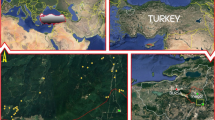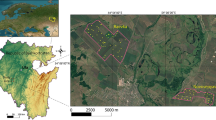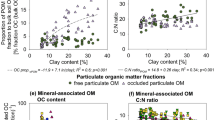Abstract
The physical properties of plowed and fallow chestnut and meadow–chestnut soils were studied in the Terek–Sulak Plain. It is shown that soil density depends both on the aggregate size and specific features of the soil formation process. In each particular case, this dependence is closely linked to the soil genesis and agricultural use. Analysis of the aggregate porosity estimated based on the percentage content of fractions shows that the major share of interaggregate porosity is attributed to large aggregates. The results can be extrapolated to other parts of the soil cover in the study area. On each studied site, an experimental soil profile cut was established, the morphological soil properties were described, and soil samples were taken layer by layer (cm) from horizons A, B1, B2, and C1 (Aplow, arable layer) for chestnut soils and from horizons A, B1, and C1 for meadow–chestnut soils. The structure index was computed based on the the sifting data as the ratio between the sum of macroaggregates (0.25–10 mm in size) and the sum of aggregates with diameters of more than 10 mm and less than 0.25 mm. The porosity of aggregate fractions 7–5, 5–3, 3–2, 2–1, 1–0.5, and 0.5–0.25 mm in size was determined from randomly selected samples of the respective fractions. Mechanical sampling was used to ensure the random selection of samples for analysis. In all of studied soils, the porosity of aggregates of the same size decreases down the profile. The sharpest decrease is observed in large (7–5 mm) aggregates: their porosity drops from 37% in horizon A to 31% in horizon C1. In small aggregates, this trend is manifested not so clearly. In chestnut soils, aggregate porosity gradually decreases with depth, while the minimum porosity in meadow–chestnut soils is observed in the B1 and C1 horizons. This pattern is manifested most clearly in aggregates 2–1 mm in size. However, the minimum aggregate porosity in horizon B1 is pronounced quite clearly not only in the 2–1 mm fraction but also in all other fractions up to 7–5 mm in size. In the C1 horizon, the aggregate porosity drops to almost identical values that are close to the computed close-packed porosity (a method involving mutual coupling of mineral particles in a clastic rock). Earlier studies have shown that aggregate porosity is closely linked to the soil composition, structure, and origin, as well as the general soil genesis that determines the fertility.

Similar content being viewed by others
REFERENCES
Currie, J.A., Gaseous diffusion in aeration of aggregated soils, Soil Sci., 1961, vol. 92, pp. 40–45.
Currie, J.A., Diffusion within soil macrostructure: a structural parameter for soils, Soil Sci., 1965, vol. 16, pp. 279–289.
Currie, J.A., The volume and porosity of soil crumbs, Soil Sci., 1966, vol. 17, pp. 24–35.
Dospekhov, B.A., Metodika polevogo opyta (s osnovami statisticheskoi obrabotki rezul’tatov issledovanii) (Method of Field Experiment with Principles of Statistical Data Processing), Moscow: Agropromizdat, 1985.
Kachinskii, N.A., Struktura pochvy (The Soil Structure), Moscow: Mosk. Gos. Univ., 1963.
Kachinskii, N.A., Fizika pochvy (Soil Physics), Moscow: Vysshaya Shkola, 1965, part 1.
Kushnarev, A.S. and Pogrelyi, V.V., Choose of soil tillage methods, Tekh. APK, 2008, no. 1, pp. 17–21.
Lebedeva, I.I., Koroleva, I.E., and Grebennikov, A.M., The evolutionary concept of chernozems in agroecosystems, Byull. Pochv. Inst. im. V.V. Dokuchaeva, 2013, no. 41, pp. 16–26.
Morkovkin, G.G. and Demina, I.V., The influence of green manure and fallow land on the fertility dynamics of leached chernozems in the moderately arid and kolkis steppe of the Altai krai, Vestn. Altaisk. Gos. Agrar. Univ., 2011, no. 11 (85), pp. 18–22.
Shevlyagin, A.I., Soil density as one of conditions of its fertility, S-kh. Proizvod. Sib. Dal’nego Vost., 1963, no. 3, pp. 43–44.
Slesarev, V.N., Influence of the structure of the arable layer on fertility and productivity in grain-fallow crop rotation, in Puti povysheniya urozhainosti zernovykh kul’tur v Zapadnoi Sibiri (The Yield Increase of Grain Crops in Western Siberia), Omsk: Omsk. S-kh. Inst., 1984, pp. 9–13.
Tabatabai, M.A. and Hanway, J.J., Some chemical and physical properties of different-sized natural aggregates from Iowa soils, Soil Sci. Soc. Am. J., 1968, vol. 32, pp. 588–591.
Teimurov, S.A., Assessment of fertility on different-level areas of pastures in arid conditions of Dagestan, Gorn. Sel. Khoz., 2019, no. 2, pp. 36–43.
Teimurov, S.A., Imasheva, S.N., and Babaev, T.T., Influence of types of fertilizers on the change of the physical properties of the meadow-chestnut soil of the Terek-Sulak valley, Zemledelie, 2020, no. 5, pp. 16–22.
Terpelets, V.I. and Slyusarev, V.N., Uchebno-metodicheskoe posobie po izucheniyu agrofizicheskikh i agrokhimicheskikh metodov issledovaniya pochv (Practical Manual for Analysis of Agrophysical and Agrochemical Properties of Soils), Krasnodar: Kuban. Gos. Agrar. Univ., 2010.
Vadyunina, A.F., Metody issledovaniya fizicheskikh svoistv pochv (Manual for Analysis of Physical Properties of Soils), Moscow: Agropromizdat, 1986.
Vershinin, P.V., Pochvennaya struktura i usloviya ee formirovaniya (Formation of Soil Structure), Moscow: Akad. Nauk SSSR, 1958.
Wittmuss, H.D. and Mazurak, A.P., Physical and chemical properties of soil aggregates in a brunizem soil, Soil Sci. Soc. Am. J., 1958, vol. 22, pp. 1–5.
Zakharov, S.A., Classification of Caucasian soils by historical, geographic, and genetic principles, in Yubileinyi sbornik, posvyashchennyi 70-letiyu professora S.A. Zakharova (Jubilee Collection of Scientific Research Works Dedicated to the 70th Anniversary of Prof. S.A. Zakharov), Kharkov: Khark. Gos. Univ., 1954, pp. 1–38.
Funding
This work was performed as part of the State Assignment, project no. 0733-2015-0002 (Develop Fertilization Techniques (Green Manure, Straw, and Manure) to Enhance Soil Fertility and Increase the Grain Maize and Grain Sorghum Harvest on Irrigated Lands in the Terek–Sulak Subprovince).
Author information
Authors and Affiliations
Corresponding author
Ethics declarations
Conflict of interests. The authors declare that they have no conflicts of interest.
Statement on the welfare of humans or animals. This article does not contain any studies involving animals performed by any of the authors.
Additional information
Translated by L. Emeliyanov
Rights and permissions
About this article
Cite this article
Teimurov, S.A., Imashova, S.N., Ramazanov, A.V. et al. Aggregation Formation in Chestnut and Meadow–Chestnut Soils of the Terek–Sulak Plain and Its Impact on Their Agrophysical Properties. Arid Ecosyst 11, 293–298 (2021). https://doi.org/10.1134/S2079096121030148
Received:
Revised:
Accepted:
Published:
Issue Date:
DOI: https://doi.org/10.1134/S2079096121030148




